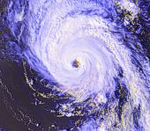Tropical Oceans: Beating Heart of Climate Change
Scientists identify tropical oceans as ‘beating heart’ of climate change
By University of Plymouth Scientists
Phys.org
The world’s oceans are increasingly pumping tropical warm water towards the poles with important consequences for life on Earth, according to a new study.
The tropical regions of the Indian, Pacific and Atlantic Oceans appear to be “acting like a heart,” accumulating heat and then pulsing it in bursts across the planet.

Warm tropical oceans are where hurricanes form and where warm water is pulsed throughout the globe. The lines show the standard paths of hurricanes. The pulsed waters discussed in this article continue north and south to the poles.
When the warm water reaches the continental shelves, it peels off in northerly and southerly directions, travelling along the shelf-line towards the poles. According to scientists at Plymouth University’s Marine Institute and the National Centre for Scientific Research (CNRS), many of the pulses coincide with El Niño events – and their heat content is increasing in intensity.
The lead author of the report, Professor Philip Reid, of the Sir Alister Hardy Foundation for Ocean Science (SAHFOS) and the Marine Institute, said the global mechanism provided an explanation for the timing and connection of a wide-range of observed hydrographic, ecosystem and cryospheric (frozen ice/snow) events.
He said:
“We have described for the first time a globally synchronous pattern of pulsed, short-term (one year) emanations of warm temperatures that pass along continental shelves, from tropical seas to the poles.
“Warm tropical waters appear to be acting like a heart, accumulating heat and energy, and then pumping it in bursts that progressively move toward the poles, a process that seems to be accelerating.”
Reid and research partner Dr Gregory Beaugrand mapped and statistically analysed average temperatures for every two-degree square of latitude and longitude, from 1960 until 2008 for the whole global ocean, with a finer single degree resolution along continental shelves. They found a remarkable degree of symmetry, both north and south of the equator, and very clear spikes in the temperature followed by a period of cooling.
Co-author of the report Dr Beaugrand said:
“We found sudden increases in temperatures in 1976, 1987, 1998, and throughout the first decade of the new millennium that coincided with well-documented ecosystem changes.”
In the late 1980s for example, the change occurred at the same time as the collapse of the cod fishery off Eastern Canada; while in 1998, there was evidence of a transarctic migration of species from the Pacific to the Atlantic that was enabled by melting sea-ice.
Dr Beaugrand said:
“When you compare the timing of these warm sea surface temperature anomalies with the reductions of polar sea-ice in the Arctic and to the west of the Western Antarctic Peninsula, and the melting of ice shelves in Antarctica and Greenland, they coincide to a strong degree.”
In conversation with Prof. Reid, Dr Doug Martinson, of Lamont-Doherty Earth Observatory, USA, described the contrast between the temperature at the bottom of the ice shelves of Western Antarctica and the warm water that is now penetrating from the adjacent shelf edge as
“comparable to a dragon blowing flames at the base of the ice”.
Professor Reid concluded:
“The discovery of this new mechanism by which heat from the tropics is being moved in this pulsating manner has major and wide-ranging implications for mankind, influencing energy consumption, weather, extreme events, the cryosphere, forest fires, heat waves, droughts and ecosystems.
“If this pattern continues, global temperatures may continue to rise in sudden jumps – and the evidence suggests that the rate of rise is accelerating.”
The report – Global synchrony of an accelerating rise in sea surface temperature – was published in the Journal of the Marine Biological Association on July 2, 2012.
By Philip C. Reid and Grégory Beaugrand
ABSTRACT: The oceans have shown a recent rapid and accelerating rise in temperature with, given the close link between temperature and marine organisms, pronounced effects on ecosystems. Here we describe for the first time a globally synchronous pattern of pulsed short period (~1 year long) emanations of warm sea surface temperature anomalies from tropical seas towards the poles on the shelf/slope with an intensification of the warming after the 1976/1977, 1986/1987 and 1997/1998 El Niños. On the eastern margins of continents the anomalies propagate towards the poles in part by largely baroclinic boundary currents, reinforced by regional atmospheric warming. The processes contributing to the less continuous warm anomalies on western margins are linked to the transfer of warmth from adjacent western boundary currents. These climate induced events show a close parallelism with the timing of ecosystem changes in shelf seas, important for fisheries and ecosystem services, and melting of sea-ice.
Source: University of Plymouth | Image: Hubbard Glacier calving from Shutterstock








Comments
Tropical Oceans: Beating Heart of Climate Change — No Comments